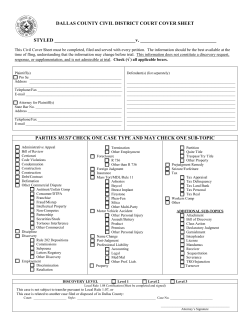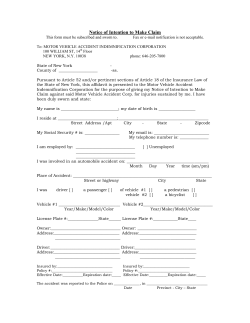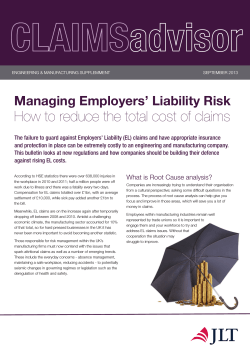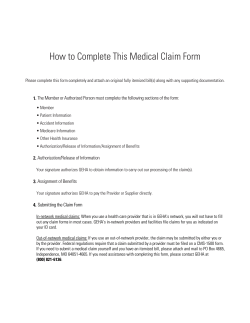
A3a
A3a
Decision and Order of the Honorable Peter P. Sweeney,
dated January 14, 2013, Appealed From
[pp. A3a - A8a)
SUPREME COURT OF THE STATE OF NEW YORK
COUNTY OF KINGS
-.--------------------~--------------------------------------------x
Index No.: 4009612007
Motion Date: 9-24-12
Motion Cal. No.: 74
HOY TELSAINT,
Plaintiff,
-against-
DECISION/ORDER
1HE CITY OF NEW YORK,
Defendants,
-.-----------------------------------------------------------------x
The following papers numbered 1 to 3 were read on this motion:
Papers:
Numbered:
Notice of Motion/Order to Show Cause
.Affidavits/ Affinnations/Exhibits.............
Answering Affirmations/Affidavits/Exhibits
,......
Reply Affirmations/Affidavits/Exhibits..............................................
Other.
1
2
3
.
Upon the foregoing papers, the within motion is decided as follows:
In this personal injury action arising out of a slip and fall accident that OCCUlTed
on the
public sidewalk abutting a residential building located at 550 Dekalb Avenue, Brooklyn, New
York, the defendant, the City of New York ("the City"), the owner of the building, moves for,
inter alia, an order pursuant to CPLR S 4404(a) setting aside the verdict on liability and
dismissing the action on the ground that the verdict is not supported by sufficient evidence.
A unified jury trial was conducted before the undersigned in March of2012. At trial,
plaintiff testified that the accident occlllTedon Wednesday, March 21, 2007, at approximately
8: 10 a.m., on the public sidewalk abutting 550 Dekalb Avenue, Brooklyn, New York, a
.residential building where she and her family were residing. She had exited the building
moments before the accident intending to go to school. She took approximately two steps from
the building onto the public sidewalk and slipped and fell on a patch of ice. She described the
patch of ice as being "crystal" in color and not too big or wide. The ice patch upon which she
slipped wasthe only ice patch she observed on the sidewalk that morning. The day before the
-1-
A4a
accident at approximately
ice on it.
10:00 a.m., when she last observed the sidewalk, she did not see any
The Friday before the accident, there was a fairly significant snow storm. Either that day
or the day after, Carlos Beriguette, the building superintendent, shoveled a path down the middle
of the public sidewalk to allow pedestrians to pass. When he shoveled, he did not clear all the
mow from the sidewalk and left some snow on both sides of the path. The sidewalk remained in
tbis condition from that time to the time of the accident. Mr. Beriguette visited the building
everyday and was there for the last time prior to the accident the day before at approximately 6
p.m. He testified that when he left the building that day, the path was free of ice. Significantly,
Mr. Beriguette was not employed by the City at the time. '
The only other witness to testify conceming the condition of the sidewalk prior to the
accident was plaintiffs brother, Rools Telsaint. Mr. Telsaint observed the sidewalk the day
before the accident as well as on the moming of the accident before the accident occUlTed. His
testimony was as follows:
Q.
A.
And what did it look like on Tuesday, the day before your
sister's accident?
I recall Tuesday got warm. And it cleaned. But like
ovemight again I saw him early on Wednesday, I said:
"Carlos what's going on?" I said, "you start cleaning it. But
it, the snow got melted. So now it kind of shifts on the path
walk. And it still there, clean it nicely as the picture shows.
As we see in the picture."
***
Q.
A.
Q.
A.
Q.
A.
Q.
A.
Q.
A.
When is the last time you were out on Tuesday?
Nighttime. Like around nine, nine.
What did you see at that time?
At that time you can see like, through the light, you can see
the patch like from, like you be able to see the ground. But
you see like patch of snow in the pathway.
Okay
And icy everything.
What?
And icy, like they become ice. You see, you look through,
you see from side to side.
When was last time you complained to Carlos about
cleaning the patch better?
Wednesday moming.
***
Q.
And how much time passed from the point where you saw
Carlos before your sister had her accident until you heard
-2-
A5a
A
I would say half an hour, 45 min. or so.
On the verdict form, the jury was asked whether the City created the dangerous condition
that caused the accident and whether it had actual notice of it. The jury answered "No" to both
questions. The jury was also asked whether the City had constructive notice of the dangerous
condition, whether the City was negligent and whether their negligence was a substantial factor
in causing plaintiff s accident. Their answers to these. questions were "Yes."
The New York City Administrative Code S 7-21 O(a) imposes the duty upon owners of
real property abutting any sidewalk, other than owners of one, two and three family residential
real property that are (i) in whole or in part, owner occupied, and (ii) used exclusively for
residential purposes, to maintain the sidewalk in a reasonably safe condition. New York City
Administrative Code, S 7-21 O(b) imposes liability on such owners for a breach of this duty and
provides that "[f]ailure to maintain such sidewalk ina reasonably safe condition shall include,
but not be limited to ... the negligent failure to remove snow [and] ice.... "
While New York City Administrative Code S 7-210(c) exempts the City from liability
for the failure to maintain the sidewalk in a reasonably' safe condition when there is an owner of
the real property abutting the sidewalk charged with the duty to maintain the sidewalk (New
York City Administrative Code S 7-210(c», the City is not exempt from liability when it "is a
property owner" within the meaning of New York City Administrative Code, S 7-21 O(b).Id.
Here, since the City was the owner of 550 Dekalb Avenue, Brooklyn, New York, which was
neither a one, two or three-family residential real property that was in whole or in part, owner
occupied, the City had the same duty that other owners of real property abutting the sidewalk
have with respect to the maintenance of the sidewalk and was subject to liability for a breach of
this duty.
While the City, as the owner of 550 Dekalb Avenue, Brooklyn, New York was subject to
liability under York City Administrative Code S 7-210 et seq., to prevail in the action, it was
still incumbent upon the plaintiff to prove the elements of a common law negligence action. See
Martinez v. Khaimov, 74 AD.3d 1031, 1032,906 N.Y.S.2d 274, 275 (2nd Dep't 2010). To
prevail against a property owner in a negligence action involving a slip-and-fall on an icy
condition, the plaintiff was required to demonstrate that the property owner created the
dangerous condition which caused the accident or had actual or constructive notice thereof. See
Gushin v. Whispering Hills Condominium L 96 AD.3d 721, 721,946 N.Y.S.2d 202,203 (2nd
Dep't 2012); Robinson v. Trade LinkAm., 39 A.D.3d 616,616-617,833 N.Y.S.2d 243 (2nd
Dep't 2007); Zabbia v. Westwood, LLC, 18 A.D.3d 542, 544, 795 N.Y.S.2d 319 (2nd Dep't
2005).
Here, since the jury found that the City did not create and did not have actual notice of
the icy condition that caused plaintiffs accident, the determinative issue on the City's motion is
whether there is legally sufficient evidence to support the jury's finding that the City had
constructive notice of the icy condition. A post verdict motion pursuant to CPLR 4404(a) for
judgment as a matter of law, made on the ground that a jury verdict is not supported by legally
-3-
A6a
sufficient evidence, can only be granted if the court concludes that there is "simply no valid line
of reasoning and permissible inferences which could possibly lead rational [persons] to the
conclusion reached by the jury on the basis of the evidence presented at trial."Cohen v. Hallmark
Cards, 45 N.Y.2d 493,499,410 N.Y.S.2d 282,382 N.E.2d 1145 (1978); see also, Rodgers v.
New York City Transit Authority, 70 AD.3d 917,919,896 N.Y.S.2d 112, 115 (2 Dep't 2010);.
Sofa v. City of New York, 63 AD.3d 1035,883 NY.S.2d 72 (2nd Dep't 2005). When
considering such a motion, the trial court must view the evidence in the light most favorable to
the nonmoving party, giving the prevailing palty the benefit of every favorable inference that can
reasonably be drawn fro111the evidence. See, Szczerbiak v, Pilat, 90 N.Y.2d 553, 556, 686
N.E.2d 1346, 1348,664 N.Y.S.2d 252,254 (1997).
"To constitute constructive notice, a defect must be visible and apparent and it must exist
for a sufficient length of time prior to the accident to permit defendant's employees to discover
and remedy it'." Crawford v. AMF Bowling Ctrs., Inc., 18 AD3d 798, 799 [2005], quoting
Gordon v. American Museum of Natural Hist., 67 N.Y.2d 836,837 [1986]; see also Cantwell v.
Rondout Sav. Bank, 55 AD3d 1031, 1032 [2008] ). When the alleged defect is an icy condition,
the injured person must. demonstrate that the property owner had constructive notice of the
specific icy condition that caused injury. (See Voss v. D & C Parking 299 AD.2d 346,347, 749
N.Y.S.2d 76, 78 (2nd Dep't 2002)1 ; Quintanilla v. State, 94 A.D.3d 846,847,941 N.Y.S.2d
715, 717 (2nd Dep't 2012); Carricato v. Jefferson Valley Mall Ltd. Partnership, 299 AD.2d
444,445, 749 N.Y.S.2d 575,576 (2nd Dep't 2002); Stewart v. Canton-Potsdam Hosp.
Foundation, Inc., 79 AD.3d 1406, 1408,912 N.Y.S.2d 773, 775 (3rd Dep't 2010)2;
A property owner's knowledge "that icy conditions may exist is not sufficient to establish
constructive notice." Piacquadio v. Recine Realty Corp., 84 N.y'2d 967,622 N.Y.S.2d 493,646
N.E.2d 795 (1994); see also Gloria v. MGM Emerald Entelprs., 298 A.D.2d 355, 751 N.Y.S.2d
213; Teodorescu v. Resnick & Binder, P.c., 55 AD.3d 721,722,869 N.Y.S.2d 95,96 - 97 (2nd
Dep't 2008); Lewis v. Bama Hotel Corp., 297 AD.2d 422,423,745 NY.S.2d 627,628 (3rd
Dep't 2002)3; Brunelle v. State of New York, Ct Cl, May 9, 2007, UID No.2007-015-551, Claim
lIn Voss, the Court concluded that a parking lot attendant's warning to the plaintiffthat
there were "patches of ice" in the lot did not establish the owner's constructive of the specific
con<;litionwhich caused plaintiff to fall.
"In short, to prevail, plaintiffs must present competent evidence establishing that
defendant knew, or should have known, of the existence of the specific condition that they claim
caused this accident ( citations omitted). "
2
3InLewis, the plaintiff testified " that upon entering the parking lot he observed scattered
patches of hard-packed snow and ice..." The Court concluded that the testimony "suffice[ed]
only to provide a general awareness that a dangerous condition might exist, which is insufficient
to establish constructive notice of the injury-producing condition."
-4-
A7a
No. 111522 [Collins, 1.].4 Likewise, a property owner's general awareness that his property or
the sidewalk abutting his property could, in certain conditions, become slippery and be covered
with ice does not establish constructive notice. See Ste'vvart v. Canton-Potsdam Hosp.
Foundation, Inc. 79 AD.3d 1406, 1408,912 N.Y.S.2d 773, 775 (3rd Dep't 2010); citing
Mosquera v. Orin, 48 AD.3d at 937,852 N.Y.S.2d 421 (3rd Dep't 2008); see also, Cantvvell v.
Rondout Sav. Bank, 55 AD.3d 1031, 1032,866 N.Y.S.2d 377 [3rd Dep't 2008]; Ronconi v.
Denzel Associates, 20 AD.3d 559, 560 (2nd Dep't 2005); Carricato v. Jefferson Valley Mall
Ltd. Partnership, 299 AD.2d 444,445 (2nd Dep't 2002).
Viewing the evidence in the light most favorable to the plaintiff and giving her the
benefit of every favorable inference that can reasonably be drawn from the evidence, there is
simply no valid line of reasoning and permissible inferences which could possibly lead rational
persons to conclude that the City had constructive notice of the specific ice patch that caused
plaintiff to fall. The testimony of the plaintiff and Mr. Beriguette was insufficient to demonstrate
constructive notice since they did not see any ice on the sidewalk when they last saw the
sidewalk before the accident. Their testimony simply does not support a finding that the ice
patch was visible and apparent and existed for a sufficient length of time prior to the accident to
permit defendant's employees to discover and remedy it.
Mr. Telsaint's testimony was also insufficient to establish constructive notice since "it
merely addressed general conditions in the vicinity rather than the origin of the specific ice on
which the plaintiff fell." Castro v. Maple Run Condominium Ass'fl, 41 AD.3d 412,414,837
N.Y.S.2d 729, 732 (2nd Dep't 2007), quoting Reagan v. Hartsdale Tenants Corp., 27 AD.3d
716,718,813
N.Y.S.2d 153 (2nd Dep't 2006).
To the extent that plaintiff is claiming that the f0n11ation of ice on the sidewalk was a
"recurring condition" for which liability can be imposed on the City is without merit. While "a
defendant who has actual knowledge of an ongoing and recUlTing dangerous condition can be
charged with constmctive notice of each specific reOCClmence of the condition" (Osorio v.
Wendell Terrace Owners CO/po 276 AD.2d 540,540 (2nd Dep't 2000), citing, McLaughlan v.
Waldbaums, Inc., 237 AD.2d 335,336 (2nd Dep't 1997) ; Connor-Miele v. Bm"hire &
Holzinger, 234 AD.2d 106 (2nd Dep't 1996); Chin v. Harp Mktg., 232 AD.2d 601 (2nd Dep't
1996), here, at best, the City only had a "general awareness" that there may be some dangerous
condition present on the sidewalk caused by the inclement weather. It was not established that
the City had actual knowledge of an ongoing and reculTing dangerous condition in the area
where plaintiff fell.
41nBrunelle, the court stated "proof which establishes no more than a general awareness
that outdoor areas become wet or icy during inclement weather is insufficient to establish
constructive notice of the specific condition causing the injury ... [citations omitted]"
-5-
A8a
For all of the above reasons, it is hereby
ORDERED that the City's motion insofar as it seeks an order pursuant to CPLRg
4404(a) setting aside the jury's verdict on liability the ground that the verdict is not supported by
sufficient evidence and dismissing the action is GRANTED. The motion insofar as it seeks
other relief is DENIED as moot.
This constitutes the decision and order of the Court.
1
HON. PETER P. SWEENEY, J.S.C:
Dated:
January 14,2013
-6-
© Copyright 2025










